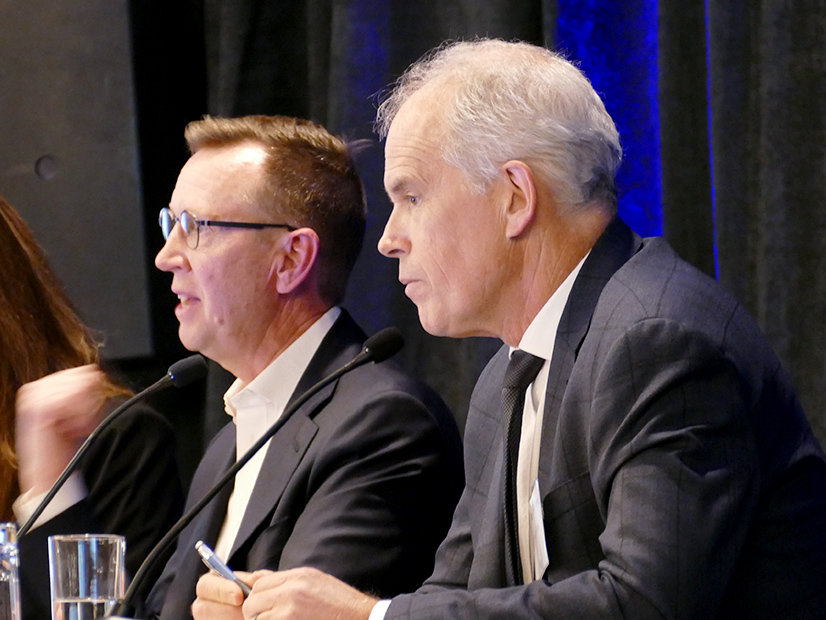INCLINE VILLAGE, Nev. — FERC Commissioners Allison Clements and Mark Christie offered their thoughts on Western market formation to a large gathering of state regulators and stakeholders at last week’s meeting of the Committee on Regional Electric Power Cooperation and the Western Interconnection Regional Advisory Body (CREPC-WIRAB).
Christie urged caution on joining an RTO, and Clements said “bigger is better” when it comes to organized markets. But both said the West will have to make its own decisions on market options.
Those options now include the Western Power Pool’s Western Resource Adequacy Program (WRAP), SPP’s planned RTO West and its Markets+ day-ahead offering, and CAISO’s extended day-ahead market for its real-time Western Energy Imbalance Market (WEIM). A legislative effort is underway that could eventually allow CAISO to become a multistate RTO. (See related story, Western Day-Ahead Markets Debated at CREPC-WIRAB.)
Clements compared the situation to a “dating process,” a metaphor she said she had borrowed from others at the meeting. And like other speakers, she noted the difference between pre-pandemic circumstances in the West and the current push toward Western regionalization.
“You really have made great progress in the last two and a half years,” she said. “Before COVID, everyone was just kind of looking around and checking each other out, and, wow, we come back from COVID and things have gotten serious.”
“I want to be clear that FERC’s job is not to be the parents to choose for you,” she said. “We’re not going to choose between the banker and the lawyer. We’re not going to choose between the banjo player and the marketer. Right? You are going to make a decision on your own.”
Clements pointed to the $3.4 billion in cumulative benefits obtained by participants in CAISO’s WEIM as evidence of the value of market development. The market allows participants to trade inexpensive renewable resources and to optimize dispatch across portions of 11 Western states and one Canadian province.
“The benefits of the EIM have really kind of shut the door on the question of whether or not increased market optimization works,” Clements said. “It feels like that conversation is done. Markets designed well save customers money. That’s the bottom line.”
She also praised the progress on WRAP, a first-of-its kind effort to coordinate resource adequacy across much of the Western Interconnection. FERC approved the program’s tariff in February. (See FERC Approves Western Resource Adequacy Program.)
Decisions about whether to join WRAP, the proposed day-ahead markets or to engage in interregional transmission planning could have long-term consequences and must be considered carefully, Clements said.
“The idea that you would choose one partner for resource adequacy and one partner for the day-ahead market and another partner maybe down the line for transmission system planning creates a lot of inefficiency and leaves a lot of savings on the table,” she said.
“You know, to my mind, it’s always the case that bigger is better,” she said. “The broader the interconnected nature of the system, the more ability you have to ensure reliability in extreme weather because the extreme weather won’t cover the whole system.”
A state-led market study in 2021 estimated that a West-wide RTO would save $833 million per year in production costs by 2030, Clements noted.
RTOs have seams agreements with each other and the ability to dispatch across those seams, and they can develop transmission while avoiding unnecessary costs and redundancies, she said.
“There are a lot of benefits that come with the full-scale development of an RTO, and there are issues to deal with as well,” she said. “I won’t pretend it’s just a rosy walk in the park.”
Seams agreements between RTOs can be especially difficult, requiring “intensive coordination,” she said.
“So, as regulators, you want to be at the table very early to think about how that coordination is going to get set up,” Clements said. “It’s not the kind of thing you want to leave and punt down the road and just see how it goes for a while.”
“Those are the questions I’m asking myself, as I see you all asking yourselves and engaging in these conversations around ‘what and where do we go from here?’” Clements said. “I will say I’m really impressed by where you are. And I look forward to continuing to watch you all and support you all trying to figure out your next steps.”
‘Lowest Rates in America’
In a separate session, FERC Commissioner Mark Christie weighed in on the question of whether Western states should join an RTO.
“You in the West will decide for yourselves what you want to do,” said Christie, who noted the range of options between doing nothing and joining “a full-scale RTO with all the bells and whistles.”
The West could come up with a unique construct that’s not being used elsewhere in the U.S., Christie said. Market choices, including real-time and potentially day-ahead market choices, could be meshed with a resource adequacy program such as WRAP, which Christie lauded as being creative, simple and voluntary.
“What could be more simple than having load-serving entities mutually pledge to reach certain resource requirements and to make available their excess resources when another participant needs it?” he said. “And to help each other in a reasonable way and on a voluntary basis.”
Another aspect of the RTO decision is what a state utility commission would relinquish in choosing to go with an RTO.
“If you want to give up your transmission planning, you’ve got to ask yourself, what am I giving up?” said Christie, who served 17 years on the Virginia State Corporation Commission before joining FERC in 2021. “Well, you’re giving up the ability … to control how assets are going to be deployed and how much money is going to be spent and how the costs are going to be allocated.”
“Maybe you want to do that,” he added. “Maybe that works for you. My point is, don’t accept unskeptically the benefits of any construct.”
Putting customers first should be the driving interest for state and federal regulators, Christie said. He pointed to three Western states — Utah, Idaho and Wyoming — that had the lowest electric rates in the nation as of the morning of his presentation.
“If the promise of an RTO is [that] it’s going to save us all this money, and we’re sitting here in these three states and we have the lowest rates in America, the question would be, ‘Seriously? … It’s going to save us money? How?’”



